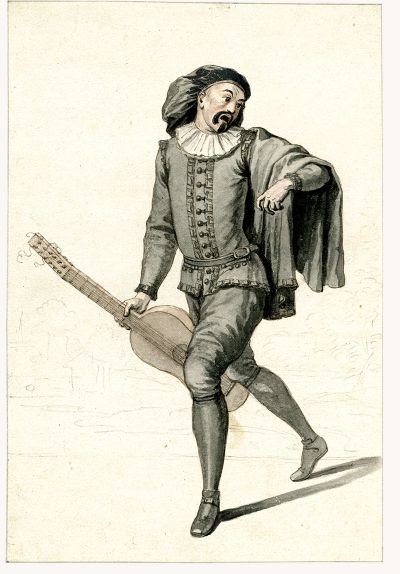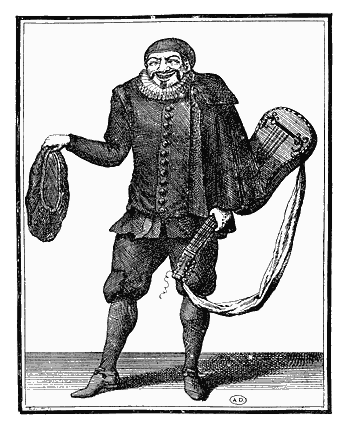

By the year 1680 the Spanish Captain goes out of vogue, so another kind of Captain, Scaramuccia (better known as Scaramouche as he was widely popular in France and England) took over the image.
Scaramuccia literally means "small, fast fray" giving the idea of a soldier who doesn't involve himself too much in the battle, and this is his way of fighting too, a little touch here, a short attack there.
More of a woman hunter than a soldier, in reality, great friend of Pulcinella, Scaramouche is less boasting than his predecessors, and more adroit and clever, besides being lucky in his maneuvering, he always finds a way of reversing the consequences of his acts on somebody else.
The mask of Scaramouche is indelibly tied to Tiberio Fiorilli, who impersonated it all his life, and made the character famous and appreciated all around Europe. Wherever he went, the Scaramouche character was received with great enthusiasm, his success terrific.
Talented and artistic, the Fiorilli-Scaramouche was also strong, agile, graceful, sang with a good voice and played the lute. This is also why in most of the prints of Scaramouche show him with a lute or a guitar
Fiorilli's fame spread fast into France and England, where he was always invited to play for the Kings and Queens of the time.
One of the more recognized talents of Fiorilli was his great ability with the pantomime, and the ability he had to transmit emotions, not only laughter, to the audience only through gesturing.
Scaramouche's Epitaph:
"Las! Ce n'est pas dame Isabeau
Qui gist là-dessous ce tombeau,
Ni quelque autre sainte Nitouche:
C'est un comique san pareil.
Comme le ciel n'a qu'un soleil,
La terre n'eut qu'un Scaramouche."
"Hey! It is not Madame Isabelle*
Who rests in this tomb
Nor any very pretentious Saint:
But a comedian without peer.
As heavens have only one sun,
Earth only had one Scaramouche."
* reference to Isabella Andreini? maybe.

